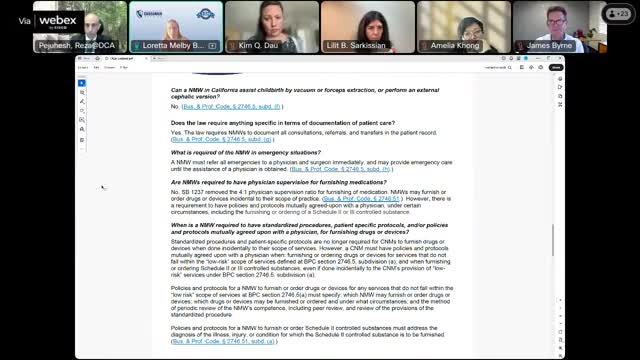Nurse Midwives Policy Review Addresses Supervision and Drug Protocols in California
September 30, 2025 | California Board of Registered Nursing, Boards and Commissions, Executive, California
This article was created by AI summarizing key points discussed. AI makes mistakes, so for full details and context, please refer to the video of the full meeting. Please report any errors so we can fix them. Report an error »

The Board of Registered Nursing's Nurse Midwifery Advisory Committee convened on September 23, 2025, to discuss updates and clarifications regarding the scope of practice for nurse midwives in California. The meeting focused on frequently asked questions (FAQs) related to childbirth assistance, documentation requirements, and emergency protocols.
The committee confirmed that the top three questions regarding childbirth assistance with vacuum or forceps, documentation of patient care, and emergency situations remain unchanged from previous FAQs. Nurse midwives are not permitted to assist with childbirth using vacuum or forceps or perform external cephalic versions. They are required to document all consultations, referrals, and transfers in patient records and must refer all emergencies to a physician or surgeon immediately, although they may provide emergency care until assistance arrives.
Significant updates were made regarding the supervision requirements for nurse midwives. The committee announced the removal of the physician supervision requirement for furnishing medications, along with the previous 4:1 supervision ratio. Nurse midwives can now furnish all drugs and devices incidental to their scope of practice. However, for Schedule 2 and Schedule 3 substances, they must have mutually agreed-upon protocols with a physician.
The committee also addressed the necessity of standardized procedures and patient-specific protocols. It was clarified that standardized procedures are no longer required, but policies and protocols must be mutually agreed upon with a physician when the practice falls outside of low-risk categories.
During the meeting, a member raised concerns about the language used in the FAQs regarding the scope of practice, suggesting it should align more closely with statutory language. The committee agreed to update the document accordingly.
Public comments were invited, with one participant suggesting additional clarifications regarding the procurement and dispensing of drugs, as well as the protocols for abortion services. The discussion highlighted differing interpretations of statutory requirements related to abortion services, particularly concerning the need for additional training and the implications for mutually agreed-upon protocols.
The committee acknowledged the complexity of the issues raised and agreed to further review the legal interpretations surrounding abortion services and the necessity of additional protocols. They proposed to strike the FAQ question on abortion until further clarification could be obtained.
In conclusion, the committee approved the updated FAQs with the noted corrections and agreed to revisit the abortion-related questions after further legal review. The meeting underscored the ongoing efforts to clarify the scope of practice for nurse midwives while addressing the evolving landscape of healthcare regulations in California.
The committee confirmed that the top three questions regarding childbirth assistance with vacuum or forceps, documentation of patient care, and emergency situations remain unchanged from previous FAQs. Nurse midwives are not permitted to assist with childbirth using vacuum or forceps or perform external cephalic versions. They are required to document all consultations, referrals, and transfers in patient records and must refer all emergencies to a physician or surgeon immediately, although they may provide emergency care until assistance arrives.
Significant updates were made regarding the supervision requirements for nurse midwives. The committee announced the removal of the physician supervision requirement for furnishing medications, along with the previous 4:1 supervision ratio. Nurse midwives can now furnish all drugs and devices incidental to their scope of practice. However, for Schedule 2 and Schedule 3 substances, they must have mutually agreed-upon protocols with a physician.
The committee also addressed the necessity of standardized procedures and patient-specific protocols. It was clarified that standardized procedures are no longer required, but policies and protocols must be mutually agreed upon with a physician when the practice falls outside of low-risk categories.
During the meeting, a member raised concerns about the language used in the FAQs regarding the scope of practice, suggesting it should align more closely with statutory language. The committee agreed to update the document accordingly.
Public comments were invited, with one participant suggesting additional clarifications regarding the procurement and dispensing of drugs, as well as the protocols for abortion services. The discussion highlighted differing interpretations of statutory requirements related to abortion services, particularly concerning the need for additional training and the implications for mutually agreed-upon protocols.
The committee acknowledged the complexity of the issues raised and agreed to further review the legal interpretations surrounding abortion services and the necessity of additional protocols. They proposed to strike the FAQ question on abortion until further clarification could be obtained.
In conclusion, the committee approved the updated FAQs with the noted corrections and agreed to revisit the abortion-related questions after further legal review. The meeting underscored the ongoing efforts to clarify the scope of practice for nurse midwives while addressing the evolving landscape of healthcare regulations in California.
View full meeting
This article is based on a recent meeting—watch the full video and explore the complete transcript for deeper insights into the discussion.
View full meeting
